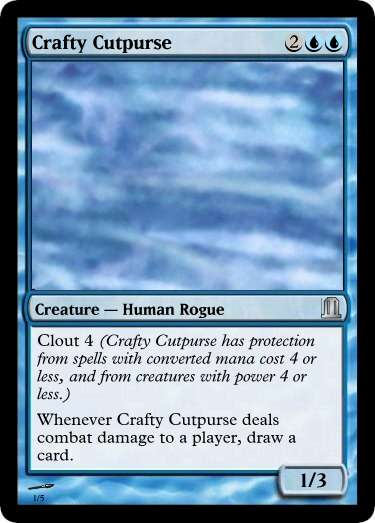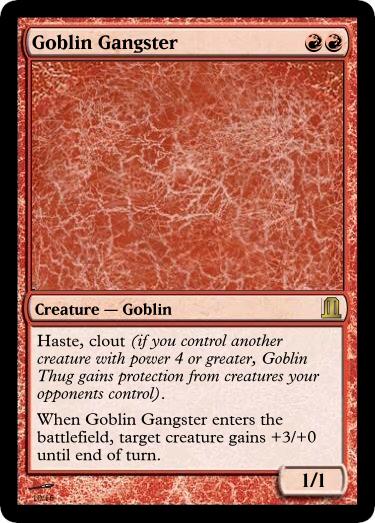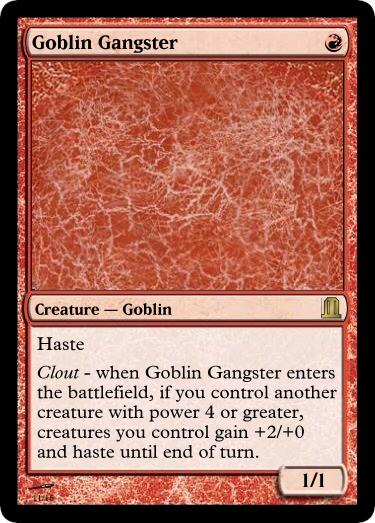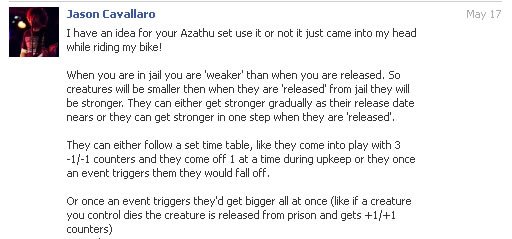Sometimes, an idea is good, but in execution it just doesn’t work.
I can’t objectively say whether clout is/was good, because the testing I’ve done has been pretty limited.
Before the end of this week’s piece, I’ll offer you the opportunity to download the playtesting set thus far and to express your feelings on the way the mechanic works (clout will still exist, we just need it to be dialed back).
Since last we spoke, I recorded an album with my band, and I’ve had some time to reflect on different aspects of some of the criticisms I’ve received regarding Azathu.
Aside on some of my pastimes
Speaking of criticisms, I’m not sure if you’re aware of this, but I’m a bit of a troll. I’m not just a bit of a troll, but I actually belong to part of a troll collective. It’s unnervingly difficult to bite my tongue sometimes when people are “harsh.” Not because the criticism is particularly hurtful (you’d be surprised what it takes to offend me), but because I am stemming my terrifying and awesome powers for the good of community involvement. And also because part of designing Magic cards (or anything) as a team member is brainstorming and hearing why your ideas are bad.
With that said, I’d like to ask people to be specific. If you see a problem, it’s really helpful for you to tell me exactly what that problem is versus being veiled and bizarrely passive-aggressive. I mean, someone, we’ll call him “Geordie T” because I don’t want to name names, seemed to have a lot to say a couple weeks ago but didn’t offer any specific suggestions for how to improve this project to make it feel more communal. That’s what I’m getting at: this is our project. I might have put myself at the helm like so many Magic Captain Ahabs, but let’s be aggressive-aggressive if we’re going to be aggressive at all. It’s certainly classier to show me your teeth for realsies “G. Tait,” or, y’know, give me some non-vitriol feedback.
End aside
Now. Clout has a problem. A HUGE problem. It’s just everything having shroud for the first X turns, and like, the weakest creatures with clout if printed at common would probably just make any kind of Limited format degenerate. For reference:

This is just an almost invincible, essentially unblockable Ophidian. This is probably way too good. Forget probably, it’s just way over-the-top too good. In testing it in a U/W Standard Control deck this is just a really powerful card engine that serves as like a higher curve, never-gonna-accidentally-kill-you Dark Confidant. So let’s talk about clout.
Clout arose from the idea that a certain creatures should have “influence” over other creatures. When you see a gang leader, he’s not always the toughest guy in the gang, right? Sometimes he’s just the smartest or the most manipulative. So how do we show that a small creature can cow larger creatures? This was the question I was looking to answer, but I think it’s important to step back and remember that goal number one is fun and clout in its current form doesn’t allow for a lot of that.
Here are some other versions of clout we could give a try:
Clout (If you control another creature with power 4 or greater, CARD NAME gains protection from creatures your opponents control.)
This makes the design simpler, gives the creature a “gang member/leader” feel, and keeps the creature from just being an indestructible hexproof creature. That feel is what we’re really looking for, and while I’m not saying this is the be all end all version, it’s certainly an improvement over the earlier incarnation. It also makes it feel like the other creatures are “lackeys,” which feels right on bigger and smaller creatures. I’m actually inclined to err on the side of caution with this and make the number 5 or greater, but I’m willing to give it a shot with these stats.
Here’s an example of a card from last time, reimagined with this new version of Clout:

What I like here is that the Goblin can one-shot make a creature bigger, including itself, to make it a potent turn 2 play but also make it an unblockable creature later on. Combine this with something like Goblin Guide and you have a really powerful start.
Here’s another way Clout could go:
Clout — When CARD NAME enters the battlefield, if you control another creature with power 4 or greater, {EFFECT}.
I used to have a problem from a “feel” standpoint of ability words (like chroma, morbid, and landfall #foreshadowing) because they felt like superfluous text. Now though, I feel like there is a lot more to ability words and their… *ahem* ability to tie things together thematically.
Here’s another try at Goblin Gangster:

This one certainly has more of what a red mage is looking for. It’s like a Vexing Devil that doesn’t suck. It is an aggressive turn 1 play, but it also has some swagger later on in the game, where it can definitely serve as your “kill spell.”
Which version of the new Clout do you like better? The mechanic or the ability word?
A friend of mine, a Mr. Jason Cavallaro, suggested that we want to use something to illustrate creatures getting stronger as time progresses (you know, like people who work out or read a lot in prison). This was how he presented it:

His idea for execution seemed a little Belligerent Hatchling esque but made sense from a feel standpoint. His initial idea was a little clunky but definitely got the wheels turning for me. It was just one more way to illustrate characters being in a prison environment.
There’s a quick fix ability word that covers the feel that Jason suggested, and we can either use that word or a variation on it to convey what we’re looking to convey. That ability word is threshold.
I haven’t had a chance to play around with designing threshold cards or nouveau threshold cards as of yet, and at the advice of a friend who once worked in Magic R&D, I’ve elected to try testing things, at least in goldfishing, but very preferably in actual games before releasing them to you to try out and test further.
So question number two becomes do we just bring back Threshold? While I totally heart threshold and the feel seems perfect, I don’t know that we want the graveyard to play a part here. How would I rationalize a graveyard making a character in a prison stronger? The other possibility would be to design some other version of threshold, but that’s kind of been done as hellbent has it not? We could have an ability word like this, for example:
Brink — If you have 25 or fewer cards in your library, {EFFECT}.
I kind of like this idea, but isn’t this almost always going to just be a harder-to-achieve threshold? I mean, you start with 53 cards in your library, and in Limited you start with 33. Isn’t it stupid how much better this ability is in Limited than it would be in Constructed? I mean, this would make a card like this:
Ancestral Hunger  U
Instant
Draw a card.
Brink — If you have twenty-five or fewer cards in your library, draw three cards instead.
An amazing Limited draw-spell and a Visions of Beyond in Constructed. And as Visions of Beyond has taught us, it’s not easy to get twenty cards into your graveyard—even when we’re trying! There are certainly worse things you could be doing with your mana, but wouldn’t it just be more appealing if it was a threshold card instead?
Fever Dream U
Sorcery
Look at the top two cards of your library; put one into your hand and one into your graveyard.
Threshold — If you have seven or more cards in your graveyard, Fever Dream has flash.
These are quite different cards from one another but fulfill the desire to have a card that is vastly better when a certain condition is met. Does one feel more prison-y though?
Speaking of mechanics, don’t we have a story we’re supposed to be working on? Let’s flesh it out some more here.
This week I want to focus on the gangs and the gang lords. The first question is how do we separate these factions? Doing it by color/color-group seems amateurish, but it also seems simple (and also, I’m an amateur), and that’s probably the best way to do things in design (if Mark Rosewater is to be believed). So let’s break them down by color:
White —Â Knights of Nothing
As ironic a name as the “knights” are feared, the Knights of Nothing are elite combatants with extreme loyalty to a set of zealous ideals. Their motto, Loyalty and Honor, is laughable, as they are only loyal to their ancient beliefs and only honorable until they vie with each other for leadership. If their weakness is their infighting, their strength is that most of the Knights of Nothing are highly disciplined soldiers, all of them qualified to lead a battle of devastatingly precise tactics. Their leader is Sheya, an exiled soldier who forged a mutiny and an eventual coup. The uprising would cost hundreds of his countrymen their lives, but more importantly led to the destruction of an important magical relic, all for Sheya’s greed.
Blue — Order of the Echo
The Order of the Echo believe in learning from magic above all else. They attempt to be non-confrontational, but being the physically weakest of the gangs of the Tower, other factions may try to goad them into combat. They are mostly defensive but will try to manipulate the day-to-day happenings of the Tower when they can to an advantage. They are led by the sorcerer Dalmon, a man sent to the Tower for experimenting on thousands of beings, genetically altering them or watching them die painfully as a result of his modifications.
Black — The Nefari (I feel like this is a name already in use somewhere)
The Nefari are a gang which preaches offerings of mutilation, life-sacrifices, and ancient and archaic medicines. They call themselves healers, but most inmates who trust them end up obligated to them either for their lives or with their lives. Their leader is a vampire called Mollix, forever cast out of his home plane for feasting on the wealthy.
Red — Bloodbrothers
 A tight-knit group where challenges to leadership at any level are seen as a rite of passage. The Bloodbrothers are fierce and passionate combatants who spend all of their time training to their physical peaks. They recognize that different races have different levels of “physical perfection” and adopt the strongest of any race, regardless of how big or small that makes them by comparison. Almost a “fight club” as much as anything else, anyone caught not involved in combat is put to death without trial. They are led by Murask, a barbaric Viashino queen evicted to the Tower for serving hundreds of her young as the main course at a feast for a Bask of new mates she was courting.
Green – The Felmir
Clumsy and brutish, the Felmir are the true brawn in Azathu. They act on instinct and often, “Bash first and ask questions never.” The mages they do employ draw their power from nature, and The Felmir have, as many gangs in prison will, a religious heritage which can be traced back to the druids of some long-forgotten plane. Their leader is Quard the Trollsire, a troll who was banished to Azathu for killing almost all of the male trolls on his home plane in order to be the father to all generations of future trolls there.
That’s going to wrap up this week’s installment of War of Worldcraft. Do you have any questions? If so, massage message me on Facebook and let me know what you think. I look forward to next time and seeing where this is going! WHAT SAY YOU?
Also, if you want to download Azathu and play around with the two different types of clout, get the Magic Set Editor file here. I’ll be updating it with every new column!
Best wishes!
Dave H.
